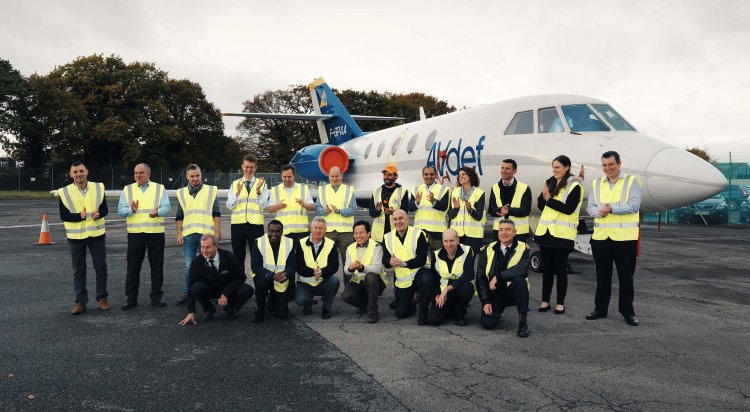Bonn, Germany, London, UK, Espoo, Finland – The European Aviation Network (EAN) has taken to the skies. Inmarsat and Deutsche Telekom, together with their technology partners Nokia and Thales have successfully conducted a programme of test flights in the UK.
This is a major milestone in the development of EAN, the world’s first integrated satellite and air-to-ground network dedicated to providing a true in-flight broadband experience for the European aviation industry and for millions of passengers travelling across Europe.
EAN is planned for introduction in mid-2017. The flights serve to test the performance of the EAN system including the onboard equipment being provided by Thales and the ground network provided by Deutsche Telekom and Nokia.
As a precursor to the test flight series, Deutsche Telekom and Nokia jointly achieved the first EAN live over-the-air connection, in Nokia’s Stuttgart laboratory. There, all components of the LTE ground network were thoroughly tested and validated. The first live connection in the field was accomplished in a broadband video conference with both parties connected via the dedicated EAN LTE mobile network.
“We are happy that we achieved a major milestone in building the European Aviation Network. With these successful tests we once more underline our goal to be the leading European telecommunications operator,” says Claudia Nemat, Board Member Europe and Technology at Deutsche Telekom. “The EAN allows us to offer our customers outstanding connectivity services not only on the ground but also in the sky. The new technology based on LTE standard makes sure that EAN is flexible for any further technology developments in the future. Deutsche Telekom’s aim is to drive technology leadership to bring best network experience to our customers.”
Leo Mondale, President of Aviation, Inmarsat said: “EAN is progressing extremely well, both on the ground as well as in the air, to achieve the world’s first integrated service providing true in-flight broadband experience. The actual performance and quality of the in-flight datalink exceeds design expectations and is truly game changing for European airlines. We look forward to further successful testing milestones working with all the EAN partners to bring together this integrated system.”
Thorsten Robrecht, Vice President, Advanced Mobile Networks Solutions at Nokia says “Nokia is extremely excited to be a pillar of the European Aviation Network project. As a global leader in communications technology, we are looking forward to the close cooperation of these distinguished partners to transform the passenger experience and deliver new services with advanced in-flight connectivity.”
“We are very proud of our employees who have helped make the first flight trial a huge success and look forward to working with our partners to bring high-speed broadband to passengers and operators across Europe,” says Stephen McCann, Vice President, Avionics at Thales.
Innovation in the skies, from the ground up
To achieve EAN’s live connection of the LTE ground network, Deutsche Telekom and Nokia have adapted Nokia’s LTE base stations and Remote Radio Heads (RRH) to the frequency used for EAN, provided by Inmarsat, and build a specific base station antenna to cover the sky. The LTE ground network for EAN differs from “normal” LTE networks as it needs to work at speeds of up to 1,200 km/h, at cruising altitudes requiring cells of up to 150 km. Nokia will manage the operations for this advanced network from its global delivery centre in Romania. In addition to the live network, Nokia and Deutsche Telekom set up a full end-to-end ground network reference system in Stuttgart, Germany, including all components and integrated on-board equipment from partner Thales, to prepare for technical challenges, for example compensation of the Doppler effect due to high aircraft speeds.
The flight trial tested the performance of the onboard equipment being provided by Thales and the ground network provided by Deutsche Telekom and Nokia. Tests were performed to see if the network could successfully attach to the ground system, which it did at all four test sites located in the south west of the UK.
The systems performed multiple successful handovers between sectors and cell towers, and maintained a stable connection. The transfer of data to and from the aircraft was also tested. The outcomes have exceeded expectations for this early flight trial and provided valuable data for the development teams.
Europe, we’ve got you covered
The European Aviation Network (EAN) is an innovative integrated S-band satellite and complementary LTE-based terrestrial network across Europe that will bring unprecedented passenger connectivity to the aviation industry. It is unique in the capacity and quality of broadband internet service it brings to the dense European aviation routes; in a very small and lightweight form factor that typical broadband satellite based solutions cannot offer. Since the initial announcement of EAN in September 2015, Deutsche Telekom and Nokia have made steady progress and are on track to deliver the ground component of the project, with the on-schedule rollout of the approximately 300 antenna sites and connecting the network live over-the-air. In parallel, Inmarsat and Thales are advancing with implementing the satellite communication for EAN, having completed construction and associated sub-system tests of the satellite earlier this year. With the test flight program now underway, the EAN will be introduced in mid-2017.























